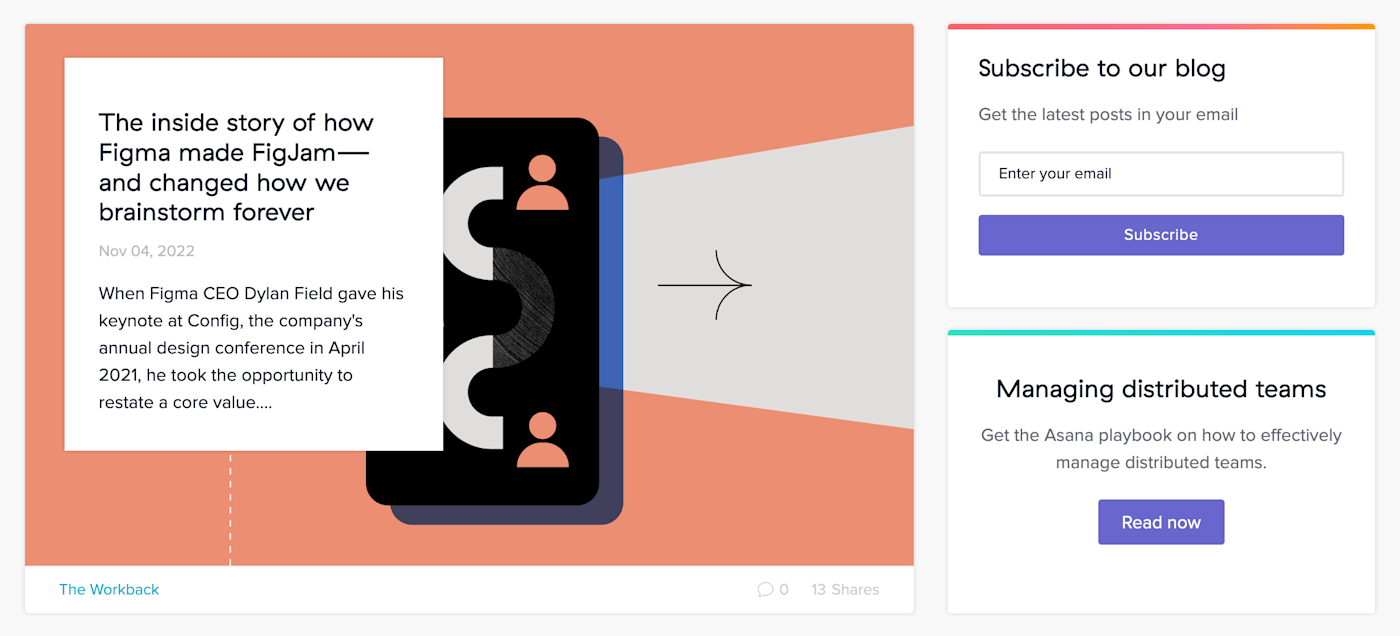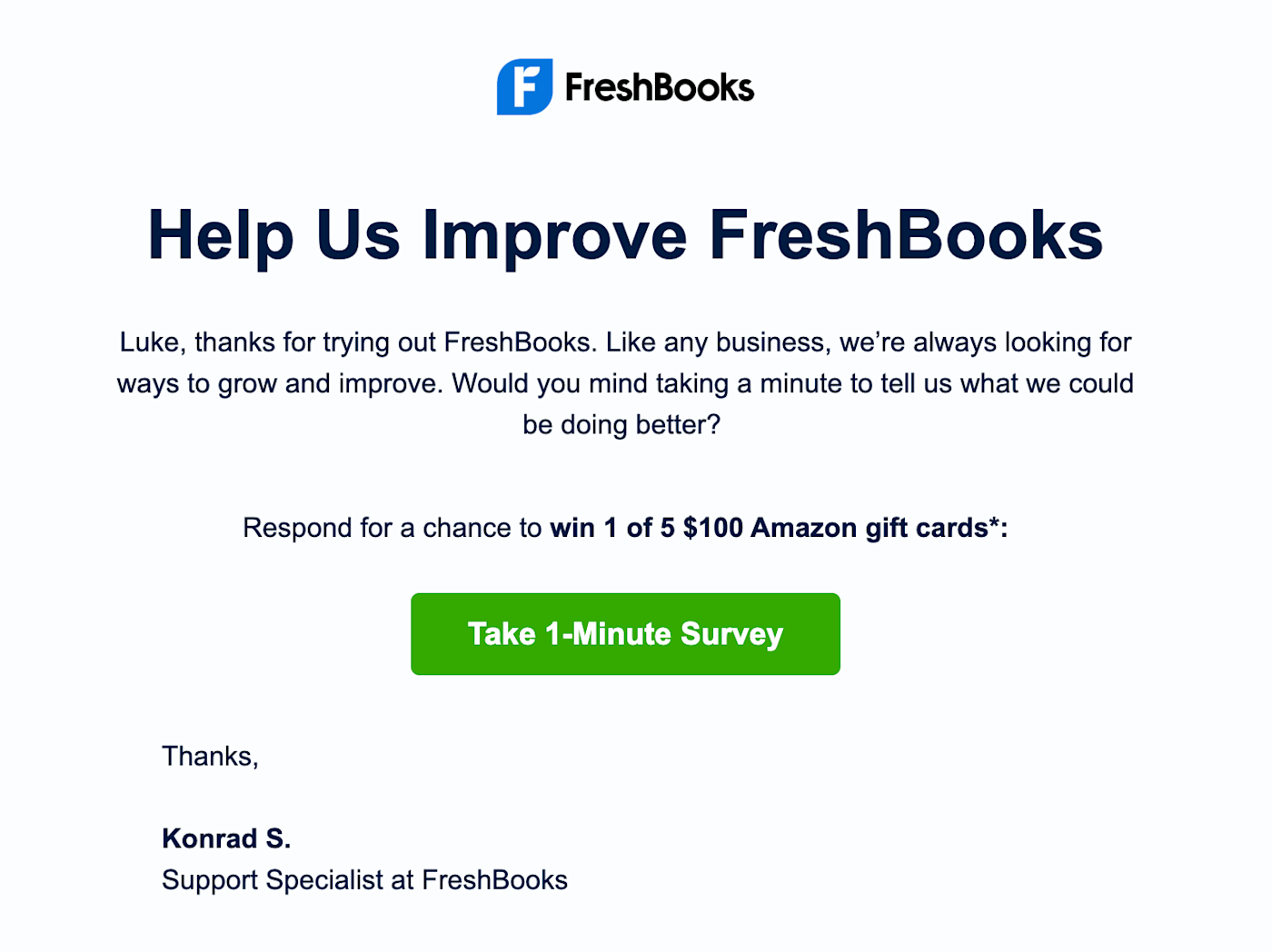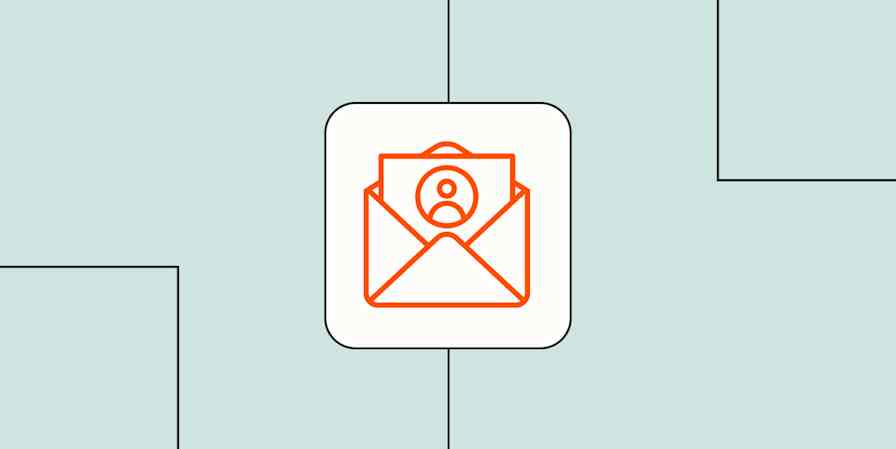One holiday season, I was doing some shopping and ordered a pack of screen-printed cat t-shirts for myself. A few weeks later, I started getting emails from the brand advertising its latest collection of winter wear. And you'd better believe it: I'm now the proud owner of the sweater set too.
I'm proof positive of the benefits of an email marketing list: I was reminded of my experience with the brand and (willfully) coerced into buying more cat-themed apparel. No matter what you sell, you need a solid email marketing strategy—and if you don't have one, you're in the right place. Below, I unpack how to build an email list that people want to be a part of.
Table of contents:
What is an email list and why is it important?
An email list is a compilation of email addresses from users who want to receive brand information and marketing content. Email lists are important because they give you a direct channel to promote products, offer discounts, and provide other information to interested customers. And unlike social media pages and many other contact points, you own your email list—giving you full control of how you use it.
The best email lists are filled with users who truly want to be on it—the ones who enjoy your brand's content and who will become repeat customers. But they also need to have enough contacts on them to have a meaningful impact on your business. And that's why it's important to find the email list-building strategies that work for your brand.
24 email list-building strategies
I gathered all my best tips for directly collecting email addresses. Use these list-building strategies to expand your network and make your campaigns succeed.

1. Create a dedicated sign-up landing page
A landing page dedicated to your email sign-up gives you the breathing room to add all the content you want without congesting the screen. It's a great way to shine a light on why your emails are so valuable.
The anatomy of a good landing page should be simple. Best practices include:
Placing the form field call to action (CTA) front and center
Including all the reasons to sign up, such as exclusives or giveaways
Offering extra encouragement, like testimonials or examples of what they'll get in a newsletter, that you can't fit on your main pages

But don't use a landing page as an excuse not to incorporate CTAs into your main pages, as they serve totally different purposes.
2. Create engaging sign-up CTAs

A CTA doesn't have to be a dull button or an unmemorable link at the end of a long paragraph. Get creative by choosing designs and copy that grab readers' attention. Be mindful of your website's use of color as you make these decisions, keeping CTA banners and buttons consistent with your branding.
3. Test your CTAs' designs and copy
Some of your CTAs might miss the mark, and that's ok. Consider A/B testing different designs and copy, tracking metrics like impressions and clicks until you create a CTA that lands. Keep your audience in mind, and make sure the clicks warrant as little effort and thought from them as possible.
4. Master the placement of your CTAs

CTA placement is just as important as appearance and wording. If email sign-ups are your top business priority, put these CTAs in the most prominent areas of the screen, like the center of your home page or in the upper-right corner of your top menu bar.
Get into the habit of placing CTAs on an "island," or separated from surrounding copy on the page with spaces, as this draws attention to them. You can also use them to split up sections on long-scrolling pages.
5. Include an opt-in link in email signatures
Professional email signatures often include links to a company website or other resources, but any CTA can go here. It's a non-invasive and accessible way to prompt users to take a certain action, like joining an email list. If it's appropriate in your industry to do so, consider asking your employees to include an email list opt-in link in their email signatures. You could also add it to the bottom of transactional emails like order confirmations.
6. Add sign-up forms to social media bios

When I'm curious about the new promotions my favorite companies are offering, I turn to social media first. It's where I expect them to post the most up-to-date, time-sensitive information. When building your email list, your company's social media bio is a great place to plug an opt-in link. If you have multiple links to share—like your email list, popular case studies, and other marketing materials—you can include them all in one convenient jump link.
7. Attend a trade show
A trade show is your company's opportunity to show itself off in an immersive and memorable way. When you provide prospective and current customers with a positive experience, they'll be far more likely to appreciate your promotional content. Be kind and professional, give them a take-home goodie bag, and hand them a tablet with the opt-in form.
8. Host an in-person event or virtual workshop
If you're worried about getting drowned out by other businesses at a trade show, you can host your own event to increase brand recognition and build your email list. Brainstorm what type of event would align with your brand image and promote it on your advertising channels. If it's a hit, you can expect your guests to sign up for marketing emails on the spot.

Not everyone will live close enough to make it to your in-person event, so you can expand your eligible audience by meeting with them online. Virtual workshops and webinars allow people from anywhere in the world to personally interact with your company. It'll increase the likelihood that they'll trust you and submit their email to learn about future virtual events. If you can, invite popular thought leaders within your industry to participate in your webinars to attract more attendees.
9. Collaborate with other other brands

There are millions of eyeballs out there just waiting to be captivated by your content, but you won't reach them if you aren't expanding your channels. Collaborating with other brands—for example, writing guest posts for reputable blogs in your niche—gives you exposure to their readers while establishing yourself as an authority.
Similarly, partnering with social media influencers allows you to leverage their followers and credibility to promote your brand. To maximize impact, ensure your content aligns with the audience's interests and provides genuine value. For example, don't try to collaborate with a running influencer if you haven't run a mile since middle school PE. And don't forget to include a CTA to sign up for more content.
10. Run an online giveaway

If a friend has ever tagged you in a comment on an Instagram giveaway post, you understand how far-reaching giveaways can be. They're a great way to spread awareness of your brand to friends of friends and get people excited to hear more from you. Consider making signing up for your newsletter a requirement to enter a giveaway, and make the prize too good to resist.
11. Use gated content as a lead magnet

Who needs money when you could have a new lead's email address? A great way to acquire leads is to offer site visitors something of value, like a free business guide, an eBook, or a template, in exchange for their email address. People are far more likely to trade their contact information than their money for a helpful resource.
If it makes sense for your industry, you can encourage readers to take a fun quiz and ask that they enter their email to receive their results. For example, a company in finance could create a "what kind of spender are you?" quiz, or a cybersecurity software company could offer a "what's your risk of password compromise?" quiz (I already know I'd wince at my results from that one).
12. Strategically time exit-intent pop-ups
No one likes to be interrupted when they're in the middle of something (and you don't want to interrupt a customer who's about to make a purchase). If you time your subscription pop-ups to appear when the user is leaving your site, you make it more convenient for them to give you their information.
For example, if someone's mouse moves toward the close button or they've been inactive for a while, that's your cue to present a compelling offer or incentive to stay connected. Some website builders and eCommerce platforms come with this kind of functionality built in, or you can use a third-party tool to get the job done.
13. Develop a helpful online tool
What tools could you offer your audience to make their lives easier? Most users will gladly submit their email if it means they get access to a tool that solves a problem. For example, a website-building company could offer a browser extension that analyzes the accessibility and visual appeal of any website. These tools might warrant some help from a developer, but the results can make the investment worthwhile.
14. Offer a free trial

If you offer software or an online service, invite users to take it for a spin before they invest big bucks in the real thing. An email address is a small price to pay to test a solution that usually costs money to use. Plus, when a user starts a free trial, it increases the likelihood that they'll sign up for the real thing. Just make sure to notify users that by submitting their email, they're consenting to receive your company's marketing emails, and that they can unsubscribe at any time.
15. Reassure would-be subscribers that you won't spam them
Most people you come across (myself included) have a moment of pause before opting into a company's email communications out of fear of spam. No matter which methods you use to build your email list, reassure users that you won't fill their inboxes with endless spam using microcopy under the opt-in button. For example, tell users:
"We won't share your email."
"We only send newsletters once a week."
"Unsubscribe anytime."
16. Start a referral program
If you aren't a hypnotist, you'll struggle to convince your subscribers to work for you for free. But by offering rewards—like discounts, exclusive content, or even freebies—you give them a tangible incentive to spread the word. For example, you could set up a system where they earn points or perks for every friend who signs up through their unique referral link. This not only boosts your reach but also strengthens loyalty, as subscribers feel valued and engaged.
17. Offer valuable blog content

Your blog is a reflection of your industry expertise. The higher the quality of your posts, the more likely people will be to follow you. Including CTAs on your blog for updates when new posts go live can help grow your email list.
18. Send out a newsletter

A newsletter is a great way to keep your customers connected to your business. Plus, it doesn't have to be overly time intensive—you can repurpose the same template time and time again. Fill your newsletters with company news and practical information related to your industry that keeps your readers engaged. For example, all Zapier customers get signed up for the Zapier user newsletter, which regularly delivers useful content.
19. Ask customers for reviews

Customer reviews give your brand a personal touch, increase confidence in your offerings, and can even boost your SEO rankings. But have you ever thought of using them to build your email list? Chances are, if a customer takes the time to leave a review, they're (at least somewhat) invested in your brand and would gladly receive promotional emails. Start by asking at the end of the survey if they'd like to subscribe to your list—and be sure to include a link for easy access.
20. Promote your email marketing efforts on social media
🗞️🗞️🗞️March 13, 2025
— ZKE Exchange (@zke_com) March 13, 2025
👏👏 U.S. February #CPI up 2.8% y/y, below market expectations
👇For more #cryptomarket news
#ZK #ZKEairdrop #Bitcoin #airdrop #crypto
✅Subscribe to our newsletter: https://t.co/N5GA8KxvZM pic.twitter.com/uJeYRbCSmO
Each social media platform poses a unique opportunity to showcase the benefits your email subscribers are reaping. Whether you tease a free course for subscribers on X or gated visual content on Pinterest, flex your social media skills to attract new subscribers.
21. Provide discounts or freebies

Consider offering a direct discount, like 20% off their first purchase, when users first sign up for your email list. And keep the excitement going by rewarding existing subscribers' loyalty with exclusive discounts or freebies in ongoing marketing emails. Word of free stuff travels quickly and is a great way to organically grow your email list.
I can already hear a conversation between a subscriber and their friend: "Where'd you get that cool sticker on your water bottle?" "Oh, this great company called [your company] sent it to me for subscribing!" "No way. Sign me up." (Just me?)
22. Offer exclusive or early access to new products or promotions
As an avid concert- and festival-goer, I'm always on the early bird list for my favorite events. If you're preparing to release an exciting new product, give your subscribers access in advance. It'll keep your existing subscribers subscribed and convince those missing out to opt in.
23. Advertise with lead generation forms
Lead generation forms are some of the most popular and effective ways to grow an email list. Whether you're using LinkedIn Lead Gen Forms, Facebook lead ads, Google lead forms, or anything else, they allow users to join your email list without ever leaving the app they're on.
24. Segment email lists
Once you collect plenty of names and email addresses, prepare for your marketing campaigns through segmentation. Maybe you gave users the option to opt in to certain promotional emails and not others, or maybe you collected some demographic information. Use that data to make sure you're sending the right emails to the right people—it'll keep all those addresses you captured on your list.

Benefits of building an email list
Just because social media marketing boomed in recent years doesn't mean email marketing is now a tactic for dinosaurs. Nearly everyone has an email address, and email marketing is one of the easiest ways to reach your customers. Here's why it benefits you to build an email list:
It's inexpensive. While you should allocate enough resources to make your newsletters and other targeted email content shine, email marketing is a relatively affordable way to reach your audience.
It reaches parties who are already interested. Unless you collected their emails without their knowledge (not recommended—or legal), you can feel confident that everyone on your list wants to learn more about your offerings, or at least thinks it's worth it for whatever you're offering in return.
It can help build loyalty. By integrating drip marketing tactics into your email marketing strategy, you can target customer segments with customized campaigns designed to make them repeat customers.
It's an owned channel. You own your email list—no social media algorithm or keyword bidding will change who you can target, when you can contact them, or what kind of content you can send them.
Why you shouldn't buy an email list
You may be tempted to buy a list with names and emails of members of your target demographic. Please don't. Here's why:
It's usually a waste of money. Many for-sale email lists are filled with email addresses of people who won't actually bring in any revenue. You're much better off attracting people you know are interested in your offerings and who willingly provide their emails.
It's more likely to annoy your recipients. How would you feel if some company you never heard of started emailing you out of the blue? Personally, I'd wonder how they got my email address and would unsubscribe before giving the email any attention.
It violates the GDPR's consent rules. If your company offers services to people living in Europe, the General Data Protection Regulation (GDPR)'s requirements apply. Its consent rules prohibit companies from reaching out to individuals without their expressed consent. Buying and using email lists is a violation of these rules and can result in legal penalties.
Still not convinced? Zapier's entire marketing team has some opinions. Here's some insight from Sean Kennedy, Marketing Operations Manager at Zapier:
"Buying an email list isn't just bad marketing—it's a minefield for your business. ESPs and ISPs use advanced filtering, track sender reputations, and even plant spam traps—repurposing old, inactive emails to catch offenders. The tiny chance of reaching a few new leads isn't worth the massive risk of legal fines, blocklisted domains, and an email reputation so wrecked that even your real customers won't see your messages. And when your emails stop reaching inboxes, your business stops reaching customers."
Common email list-building mistakes
A poorly maintained email list or ineffective strategy can lead to lower open rates, higher spam complaints, and lost opportunities to connect with your audience—all things you could file under "not ideal." To ensure your email list is healthy and effective, avoid these additional pitfalls:
Neglecting list maintenance: Failing to remove inactive subscribers or invalid emails can hurt your deliverability. For example, if most of your emails aren't opened or fail to deliver, email providers could start flagging your account as spam, making it harder for future emails to reach inboxes.
Not testing your emails: A/B test email copy and design to pinpoint what resonates with your audience and ensure any images display correctly. Skipping these tests can result in low-quality emails that head straight to the trash bin (if they're opened at all).
Sending too frequently (or infrequently): Bombarding subscribers with emails can lead to unsubscribes, while sending too few can cause them to forget about you. Monitor metrics like open rates, click-through rates, and unsubscribe rates to find what works best for your audience.
Not using double opt-in: A double opt-in process is when a consumer confirms their sign-up twice by filling out their information on your website and in a subsequent email. If you skip this step, you could gather a potpourri of fake or mistyped emails, reducing list quality and increasing bounce rates.
Automate your email list building with Zapier
If you use even a handful of these ideas, you'll be compiling your email list from many different sources. With Zapier, you can connect your email marketing software to the other apps you use—such as online forms, eCommerce platforms, and CRM apps—so all your new leads are automatically added to your email marketing software.
Learn more about how to automate your email marketing activities, or get started with one of these pre-made workflows.
Add subscribers to Mailchimp for new Google Sheets rows
Create Sendinblue contacts from new Salesforce leads
Update contacts in ActiveCampaign from new WooCommerce orders
Get email notifications or send follow-ups to new Typeform respondents
Zapier is a no-code automation tool that lets you connect your apps into automated workflows, so that every person and every business can move forward at growth speed. Learn more about how it works.
Related reading:
This article was originally published in August 2019 by Matt Ellis and has also had contributions from Dalton West. The most recent update was in March 2025.










